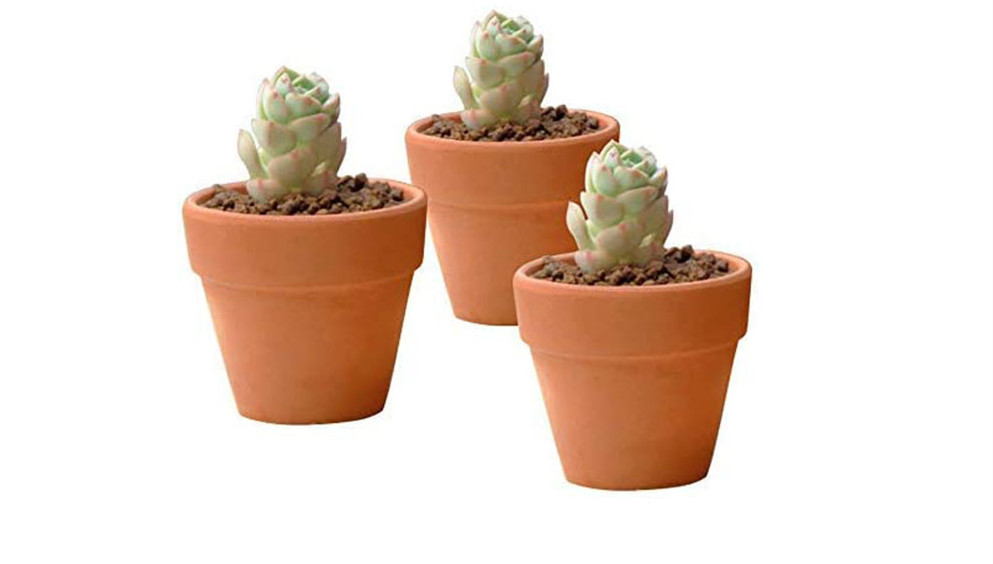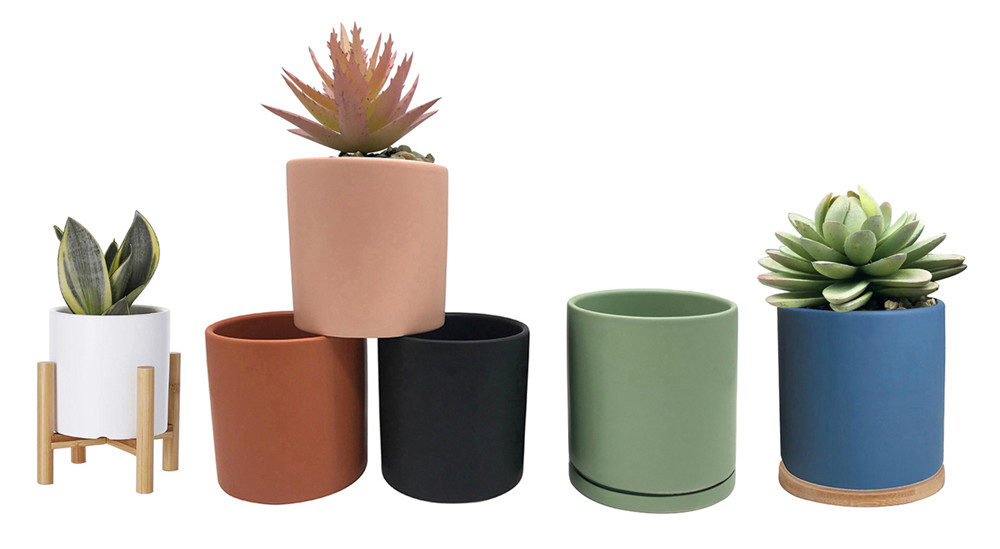Jardinera de terracota vs. jardinera de cerámica: Análisis actualizado (2024)
Hora de emisión: 2024-01-15 14:41:52
Al cultivar plantas, lo primero que debes considerar es dónde colocar las macetas: en interiores o exteriores, en el suelo o sobre una mesa. La mayoría de las macetas de terracota se usan en exteriores, mientras que las de cerámica son más comunes en interiores. Hay razones para ello. Analicemos por qué la mayoría de la gente usa este método. Pero después de cierto punto, buscas una maceta que sea duradera y bonita. Esto no significa que seas anticuado, sino que eres una persona que cuida los recursos.
Las macetas de cerámica tienen una apariencia atractiva y moderna, pero surge la pregunta: ¿son duraderas? Por otro lado, las macetas de terracota no siempre llaman la atención por su apariencia simple y, a veces, poco atractiva. Sin embargo, es importante tener en cuenta que, independientemente de si se opta por la cerámica o la terracota, ambos materiales tienen sus propias ventajas y desventajas que requieren una cuidadosa consideración antes de realizar una compra. En este blog, profundizaremos en el mundo de las macetas de terracota y cerámica, explorando sus características y ayudándole a determinar qué material se adapta mejor a diferentes escenarios de jardinería.
Macetas de terracota

Según un informe de howstuffworks , el término terracota, que en latín significa "tierra cocida", existe desde el siglo XVIII. La práctica de cocer arcilla se ha practicado desde mucho antes. Si necesita pruebas, pregúntele al ejército de soldados de terracota del noroeste de China, creado hace más de 2000 años. O considere la Venus de Dolni Vestonice, la escultura de terracota más antigua que se conoce, que data del 26 000 al 24 000 a. C.
«La terracota se refiere a una cerámica porosa de baja cocción que se ha utilizado durante milenios», explica Sarah Barack, jefa de conservación y conservadora principal de objetos del Cooper Hewitt, Museo de Diseño Smithsonian, en un comunicado por correo electrónico. «Generalmente tiene un color rojizo o rosado debido al hierro de la arcilla, que se oxida durante el proceso de cocción».
Como el material es poroso, permite el paso del aire, lo que ayuda a evitar problemas como la pudrición de las raíces. También ayuda a drenar la humedad en caso de exceso de riego. Sin embargo, también tiene una desventaja: a veces, la terracota absorbe toda el agua. Para evitarlo, puedes dejar la maceta de terracota en el fregadero lleno de agua durante la noche. Así, cuando la uses, solo la tierra absorberá el agua. Puedes mejorar esta temporada con un florero de terracota para recordar el otoño.
Las macetas de terracota se han utilizado durante siglos y son populares entre los jardineros y entusiastas de las plantas por varias razones:
1. Porosidad
Terracotta is a porous material which allows air and water to pass through the pot and reach the plant's roots. The high water permeability rate ensures that excess water in the flower pot can be drained out of the flower pot. Do not let the roots soak in water.
This is also the reason why terracotta flower pots are more suitable for outdoor use. Even with the tray there was nothing to stop the water from flowing everywhere. This promotes healthy root growth and helps prevent waterlogging or overwatering.
2. Breathability
Terracotta planters have a special quality called "breathability." This characteristic is closely tied to the porous nature of terracotta, a type of clay that allows air to flow through the walls of the pot. The term "breathability" describes the pot's ability to enable the exchange of air between the external environment and the soil inside the planter.
The breathability of terracotta plant pot is incredibly beneficial for the health of your plants. It ensures that oxygen can easily reach the roots of your plants, which in turn encourages robust and healthy growth. Moreover, it prevents the soil from becoming too densely packed, a condition that can impede the development of the roots.
This feature proves especially advantageous in preventing problems like root rot, as it assists in maintaining proper aeration and drainage within the planter. In essence, terracotta flower pot become natural allies to your plants, guaranteeing that they receive the essential oxygen and airflow required for their overall well-being.
Terracotta pots provide some insulation for the plants. The clay material helps regulate temperature, keeping the roots cooler in hot weather and providing some protection against temperature fluctuations.
3. Durability
Terracotta planters are not just famous for their breathability; they also boast remarkable durability, a quality that significantly contributes to their popularity among gardeners.
This durability stems from the fact that terracotta planters are crafted from clay that undergoes high-temperature firing during the manufacturing process. This firing process results in a robust and sturdy material capable of withstanding various environmental conditions and the test of time.
However, it's worth noting that while terracotta planters generally excel in durability, they can be vulnerable to cracking in extremely cold temperatures. Therefore, it's advisable to take precautions, such as protecting them during freezing weather.
4. Affordable
Terracotta pots are more cheaper than those made from other materials like ceramic or plastic.
Ceramic Pots

According to the history of ceramic development. Throughout the 16th century CE (CE = Common Era), earthenware remained the main class of ceramic products manufactured in Europe and the Middle East. The Chinese were the first to introduce high temperature kilns capable of reaching up to 1350 degrees, and, around 600 CE, developed porcelain (a material with less than 1% porosity) from kaolin clay. During the Middle Ages, trade through the Silk Road allowed for the introduction and diffusion of porcelain throughout Islamic countries first and later in Europe, due in large part to the journeys of Marco Polo.
Ceramic flower pots are a popular choice for both indoor and outdoor gardening. They come in a wide range of sizes, shapes, and designs, making it easy to find the perfect pot to match different types of plants and your personal aesthetic preferences.
One of the appealing aspects of ceramic flower pots is their natural look and feel. Many gardeners appreciate the authenticity they bring to their gardening spaces, as ceramic pots can mimic the appearance of natural materials.
The elegance and durability of ceramic vases also make them a highly recommended option. Their graceful designs add a touch of sophistication to any garden or indoor space, while their robust construction ensures they can withstand the test of time, offering a reliable container for cherished plants.
Although ceramics are not as old as terracotta, they are still several centuries old and are very popular with gardeners and plant lovers for the following reasons:
1. Durability
Ceramic planters are celebrated for their outstanding durability. The planter crucial step in their production involves subjecting them to high temperatures. This temperature is higher than terracotta. This process yields a robust and tough material that can withstand various challenges.
What sets ceramic planters apart is their exceptional resistance to weathering and fading. This quality makes them an exceptional choice for both indoor and outdoor gardening. Come rain or shine, exposure to sunlight, or fluctuating temperatures, ceramic planters remain steadfast. They keep their structural integrity intact and retain their visual appeal. Ceramic flower pots have better cold tolerance than terracotta pots and can withstand lower temperatures
Nevertheless, it's worth bearing in mind that ceramic planters, despite their resilience, do have a potential vulnerability. They can be somewhat brittle, which means they might chip or crack if subjected to heavy impacts or accidental drops. So, while they are incredibly durable in most respects, a certain degree of care is advisable to keep them looking their best.
2. Aesthetic Appeal
- Diseños Diversos : Las macetas de cerámica vienen en una amplia gama de tamaños, formas y diseños. Ya sea que prefieras estilos clásicos o contemporáneos, puedes encontrar fácilmente una maceta de cerámica que se adapte a tu gusto y complemente tu decoración actual.
- Encanto visual : La belleza natural de la arcilla, combinada con la creatividad artesanal de los artesanos de la cerámica, da como resultado macetas que irradian encanto visual. A menudo presentan patrones intrincados, texturas y esmaltados vibrantes que llaman la atención y aportan carácter a cualquier ambiente.
- Versatilidad : Las macetas de cerámica son increíblemente versátiles. Su versatilidad les permite integrarse a la perfección en diversos estilos de jardinería o decoración, desde rústicos y tradicionales hasta modernos y eclécticos.
- Textura y acabado : Las macetas de cerámica están disponibles en diversas texturas y acabados, como superficies brillantes, mate o texturizadas. Estas opciones le permiten elegir una maceta para suculentas que complemente sus preferencias de diseño.
- Aspecto y tacto naturales : muchos jardineros y decoradores aprecian las macetas de cerámica por su capacidad de imitar la apariencia y la textura de materiales naturales como la piedra o la terracota, agregando un toque auténtico a su espacio.
3. Retención de humedad
Las macetas de cerámica son excelentes para retener la humedad. Debido a que su temperatura de cocción es mucho más alta que la de las de terracota, su permeabilidad al agua es mucho menor, pudiendo almacenar agua. Esto elimina la necesidad de regar las plantas con frecuencia, lo cual es especialmente beneficioso para las plantas que requieren un ambiente más húmedo.
Fácil mantenimiento: El mantenimiento de las ollas de cerámica es relativamente sencillo. Se pueden limpiar regularmente con agua y jabón para eliminar la suciedad y los residuos. Sin embargo, se debe tener cuidado de no rayar ni dañar la superficie de la olla durante la limpieza.
4. Personalización
- Esmaltes y acabados : Las macetas de cerámica vienen en una amplia variedad de esmaltados y acabados. Puede elegir entre superficies brillantes, mate o texturizadas, cada una con un efecto visual único. Estas opciones le permiten combinar la apariencia de la maceta con su decoración actual o crear un tema estético específico.
- Tamaños y formas : Las macetas de cerámica están disponibles en una variedad de tamaños y formas, desde pequeñas macetas redondas hasta grandes maceteros rectangulares. Esta versatilidad le permite elegir macetas que se adapten perfectamente al espacio que tiene en mente y a las necesidades de crecimiento de sus plantas.
- Diseños y patrones : Muchas macetas de cerámica presentan diseños y patrones intrincados que puedes personalizar a tu gusto. Puedes optar por macetas con motivos artísticos, formas geométricas o incluso solicitar diseños personalizados para que tu maceta sea verdaderamente única.
- Colores : Las macetas de cerámica están disponibles en una amplia gama de colores. Ya sea que prefiera tonos vibrantes o suaves, puede encontrar o solicitar el color que mejor complemente su diseño general.
- Personalización : Algunos fabricantes de macetas de cerámica ofrecen opciones de personalización. Puedes grabar o pintar tu nombre, un mensaje especial o un logotipo personalizado en la superficie de la maceta, dándole un toque personal y significativo a tu jardín o espacio.
- Piezas complementarias : También puedes elegir piezas de cerámica complementarias como platillos, bandejas o elementos decorativos a juego que combinen con tu maceta, creando una exhibición cohesiva y visualmente atractiva.
Conclusión
En general, las macetas de terracota son muy populares entre muchos jardineros debido a su encanto natural y atemporal, además de ofrecer diversas ventajas para la salud de las plantas. Su atractivo clásico ha perdurado a lo largo del tiempo y su porosidad beneficia las raíces.
Por otro lado, las macetas de cerámica aportan funcionalidad y belleza al interior, lo que las convierte en una opción popular para la jardinería, tanto en interiores como en exteriores. Son excelentes para regular los niveles de humedad, asegurando que las plantas reciban la hidratación adecuada. Además, las macetas de cerámica son duraderas y vienen en una amplia gama de diseños cautivadores, lo que permite realzar la estética de las plantas a la vez que les proporciona un entorno de crecimiento sano y nutritivo.
RECENT POSTS
- Los beneficios de los productos cerámicos de alta calidad al por mayor para los minoristas
2025-12-17
- Se puede hacer un cenicero con arcilla de secado al aire
2025-12-17
- El impacto de los materiales cerámicos en edificios energéticamente eficientes
2025-12-04
- Los 7 principales beneficios para la salud de los utensilios de cocina de cerámica
2025-12-04
- ¿Cómo limpiar macetas de cerámica y prolongar su vida útil?
2025-11-17
- 15 de las mejores ideas de regalos navideños de cerámica para 2025: originales, elegantes y emotivos
2025-11-17
- Gres vs. Porcelana vs. Loza: Guía rápida para decidir
2025-10-09
- ¿Son seguros los esmaltes cerámicos para los alimentos? La verdad tras el brillo
2025-10-09
¿Necesitas una cotización?¿Tienes alguna pregunta?
Obtenga una respuesta de un experto en 24 horas
HABLE CON UN ESPECIALISTA >









